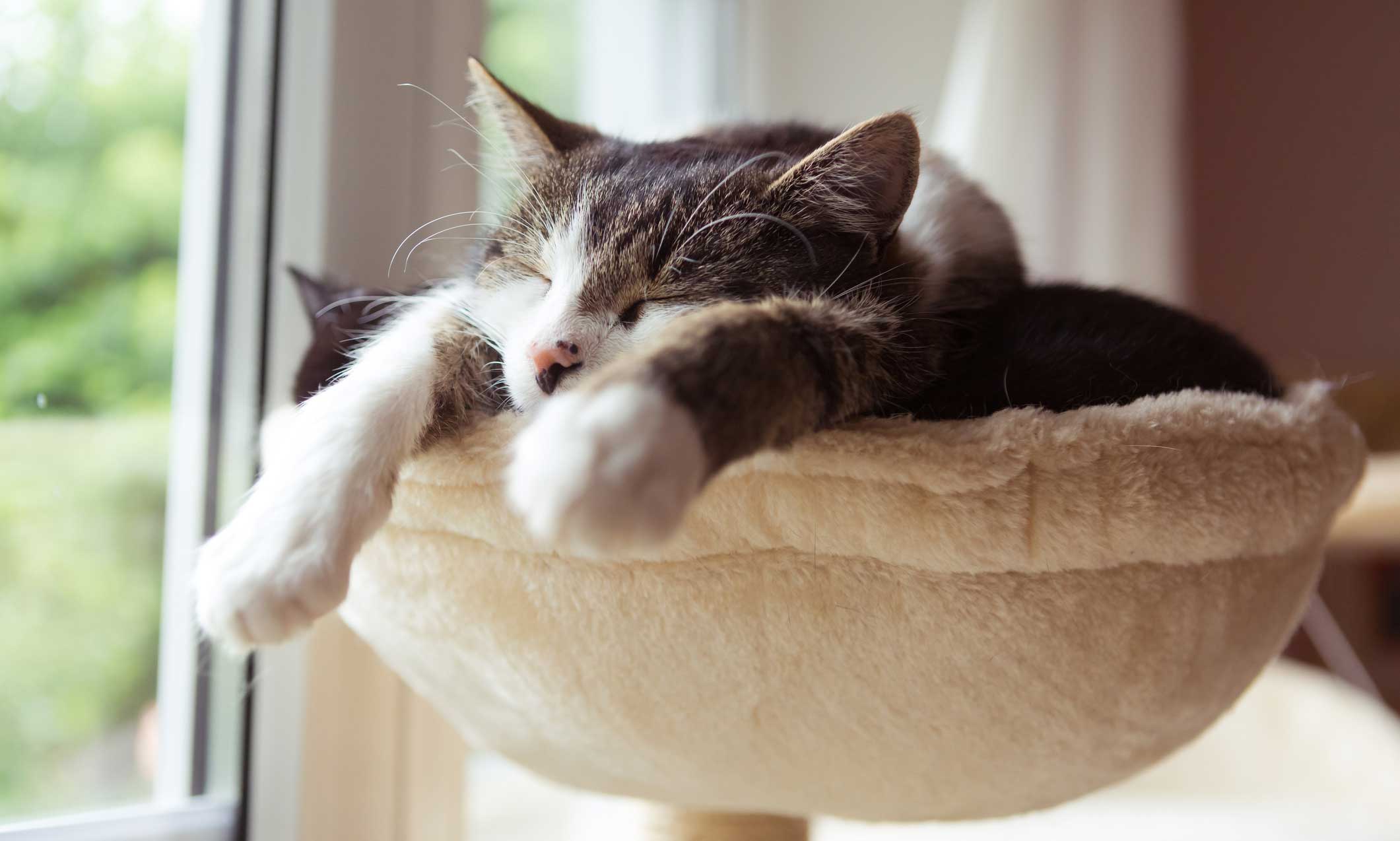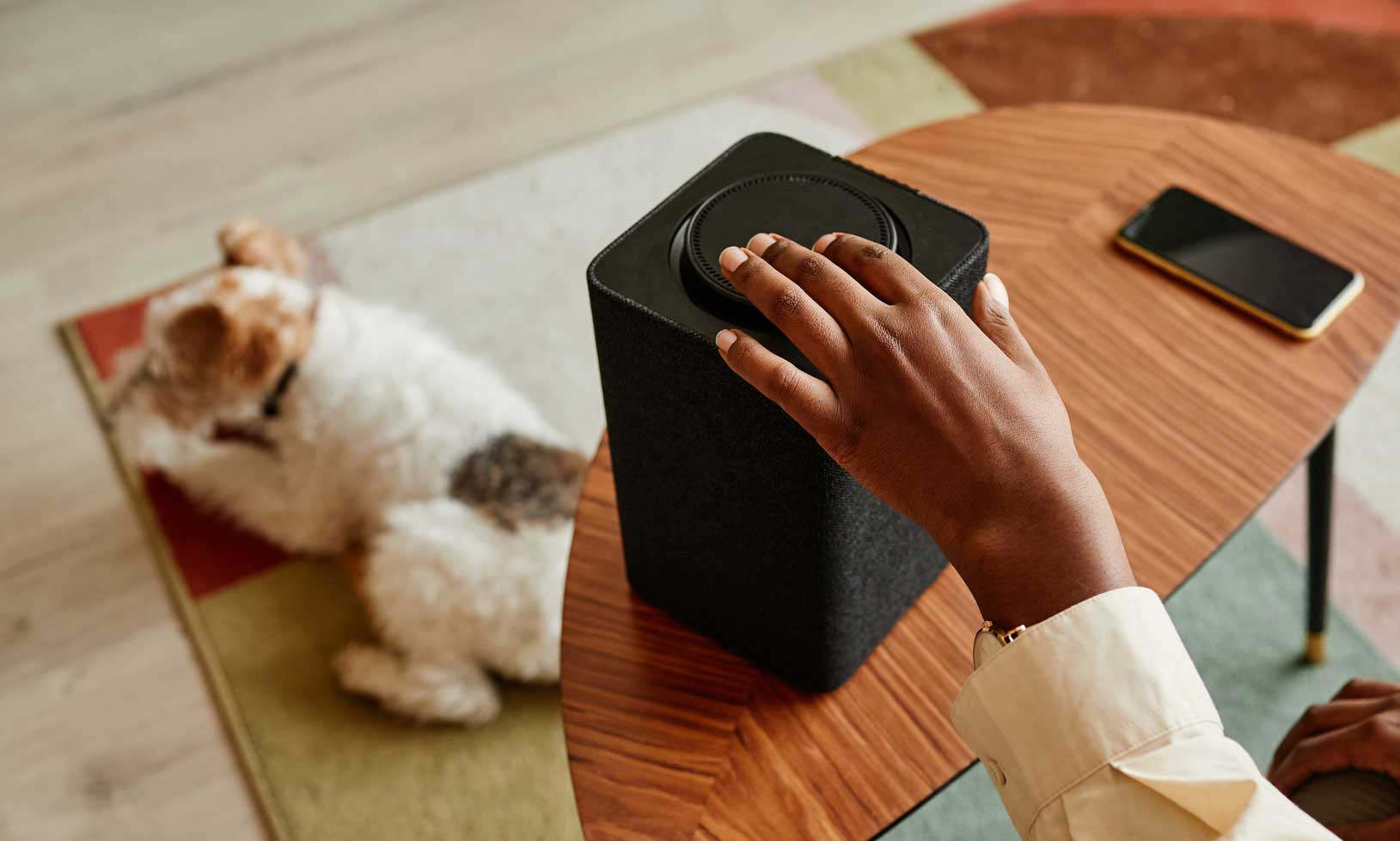Having anxious, stressed-out pets is a pet parent nightmare. You know they’re safe in your home, but despite how much you try, you just can’t calm them down. While behavior modification and over-the-counter treatments, like pheromone sprays and anxiety vests, can help, calming music for dogs and cats may be an easy fix you’re overlooking.
Research shows that playing specific types of music can reduce stress and anxiety in dogs and cats and alleviate stress-related behaviors, like excessive barking and the inability to lie down and relax.
Here, we dive into the research on which type of calming music for dogs and cats is best, speak to experts on the topics, and provide curated playlists so you can start this pet therapy right away. (And spoiler alert: The playlists work! My cat even fell asleep listening to them.)
Click to jump to each section:
How Does Music Affect–and Help–Dogs and Cats?

Sound behaviorist and founder of Pet Acoustics in Connecticut, Janet Marlow, began studying relaxing music for cats and dogs over 20 years ago, and has made species-specific music her expertise after coining the term in 1997. As an international recording artist in classical jazz, she noticed that her pets would come to her side whenever she performed at home and concluded that they were soothed by the sounds of her guitar and singing.
“Music is a language to animals,” says Marlow. “It is a powerful tool for a pet parent to utilize to help their dog or cat to live a healthier and longer life.”
Marlow worked with veterinarians and cat and dog parents to apply her research on relaxing music for cats and dogs. She found that the sound she developed could effectively balance animal behavior.
“The results proved to be able to take some pets off medications, modify separation anxiety, and help calm behavior during travel, thunderstorms and fireworks,” she says.
Does Calming Music Work for All Dogs and Cats?
But does calming music actually work for all dogs and cats? There’s no way to say, really.
While studies have shown that music typically has a calming effect, that doesn’t mean it works for every pet, every time. Just like people, dogs and cats have different personalities and different things that soothe them and set them off. While it doesn’t hurt to try, it may not be a quick fix, especially for super-anxious pets.
3 ways species-specific music can help pets:
1Reduces Separation Anxiety
Providing the correct frequency of music for pets that is known to put them in a state of calm can help reduce separation anxiety.
“When [our pets] are home alone, we don’t have control over the sounds they hear. That’s why providing the correct frequency of music … is so important,” Marlow says.
2Facilitates Dog Training
Music is not only effective at reducing separation anxiety, but it can also help keep pets calm and increase their focus during training.
“We’ve done clinical studies for puppy training classes and had excellent results of puppies having greater attention as a result of having the music playing,” Marlow says.
In one 90-day study where Marlow was observing the effect of the music on training classes, 90 percent of dogs displayed increased focus, and 86 percent of dogs appeared to have lower stress.
3Mitigates Stress During Pet Travel
Music can also calm pets down in the car, on the way to the groomer or a vet visit, or during extended travel.
“The music is the trigger for keeping their environment feeling safe and unstressed,” Marlow says. “As long as they know their environment feels safe, they will relax.”
What Kind of Music Calms Pets?

In Marlow’s studies, she discovered that each species of animal has different hearing abilities.
“Cats can hear three times as much as we do, and dogs can hear twice as much as we do,” Marlow says.
This means that the sounds we encounter in our everyday lives, like vacuums or airplanes flying overhead, are amplified for our pets.
Marlow found that each animal, as a result of their hearing range, would be calmed if the ultra-high or sub-low frequencies that keep them on alert were minimized. That means that noises that could distract the animal, like a percussion or even the voice of a human, are omitted from relaxing music for cats and dogs.
“You don’t want human voice in there, as it can be seen as a trigger,” Marlow explains.
As such, you’ll only find modified frequencies in the originally composed music. Relaxing instruments such as the piano and flute are usually included in soothing music for cats and dogs.
Classical Music for the Win
Dr. Lori Kogan, PhD, licensed psychologist and professor of Clinical Sciences for the College of Veterinary Medicine and Biomedical Sciences at Colorado State University, came to a similar conclusion while observing the behavioral effects of auditory stimulation on kenneled dogs. During an experiment, Dr. Kogan played three types of music for the dogs: classical (average beats per minute, or BPM, of 121), heavy metal (average BPM of 131) and psychoacoustically designed relaxing music for dogs (average BPM of 95).
“What the study found was that classical music did seem to have a positive impact on dogs. They were less vocal; they were lying down and sleeping more. That nervous shaking that dogs do was less when compared to heavy metal,” Dr. Kogan says.
Another review looked at six small studies. While the jury is still out on whether music can alleviate stress in highly stressful situations, like a vet visit, the conclusion from this review was that classical music was proven to reduce behaviors and physical symptoms associated with stress, like heart rate variability (HRV), level of vocalization (how much the dogs bark), and the amount of time spent resting.
Soft Rock and Reggae Help Calm Dogs, Too
In another study, researchers exposed kennelled dogs to five different types of music: soft rock, reggae, pop, classical and Motown. They found that the dogs were more likely to lie down when listening to all five types of music. However, HRV was significantly higher—a sign of decreased stress—when soft rock and reggae were played.
Cat-Specific Music Decreases Stress
In one study on cats, researchers found that cat-specific music (which is purposefully designed music for cats to relax) could decrease stress and improve quality of care in cats in a veterinary clinic. Another cat-focused study showed that both cat-specific and classical music could have a calming effect on felines.
What Kind of Music or Sounds Are Harmful to Pets?

When you’re trying to relax your dog or cat, you want to avoid these types of sounds as much as possible:
- Avoid music with reed instruments, like a saxophone or clarinet. These can mimic canine howls and agitate your dog and/or prompt them to start howling.
- Avoid loud percussion instruments like drums. Dogs’ and cats’ ears can be especially sensitive to these sounds.
- Don’t play any tracks with startling, random beats. Like thunder and fireworks, unpredictable bangs or beats in a song can startle your pets and stress them out more than it relaxes them.
- The volume is important, too. Dogs have much more sensitive hearing than humans. If you want to help them relax, you have to keep the music volume at moderate to low.
- Anything over 80 to 85 decibels can negate any relaxation, even in sedated dogs. For reference, a standard alarm clock is about 80 decibels.
How Do I Reduce Noise Pollution at Home?
Try not to introduce too much noise into your home. While certain music can be calming, really loud music and other unwelcome sounds can have the opposite effect.
In addition to playing the right type of music at the appropriate volume, you can reduce noise pollution at home by:
- Closing the windows. If you live on a busy road or there are startling sounds coming in from outside, closing your windows is a simple way to mute it.
- Lowering the volume of other electronics. In addition to paying attention to the volume of the music you’re playing, be mindful of your TV and phone volume.
- Adding rugs to your home. If you have hard floors, rugs can help dampen sound (and they may feel better to your pets, too).
- Turning off/unplugging appliances when possible. Most appliances contribute to noise pollution in some way, but you can reduce the total noise pollution by unplugging whatever you can when it’s not in use. (This can also save you some money on your electricity bill in the long run.)
- Closing doors. If you have especially loud areas of your home, dampen the noise by closing doors to block the sound from traveling throughout your home.
Our Favorite Playlists for Calming Your Pet

To give you a place to start, we put together a dog calming playlist and a cat calming playlist that you can put on repeat whenever your pet needs it.
Dog Calming Playlist
Cat Calming Playlist
Other Calming Playlists We Like
If you don’t want to put your own playlist together, you can also take advantage of some of the playlists that are already available on Spotify.
Here are some to get you started:
- The best playlist for dog anxiety: This Is Relax My Dog Music
- The best playlist for calming hyperactivity: Calming Music for Pets
- The best classical music playlist: Classical Music for Dogs
- The best playlist for when you need hours of deep sleep dog music: This Is Sleeping Music for Dogs
- The best jazz music playlist: Perfect Jazz for Pets
- The best playlist full of meditation music: This Is Meditation Music Zone
- The best playlist with nature sounds: Nature Sounds for Pets
- The best playlist full of piano music: Piano Music for Dogs
- The best reggae playlist: Instrumental Reggae
- The best playlist for separation anxiety relief: 15 Hours [of] Soothing Dog Music
- The best soft rock playlist: Soft Rock for Dogs
- The best playlist for stress relief: This Is Pets Relax
How Do I Make My Own Calming Music for Dogs?
If you’re musically inclined and you want to make your own calming music for cats or dogs, there are some things to keep in mind.
Aside from avoiding reed and percussion instruments, you’ll want to:
- Keep the decibel level around 25.
- Stick to melancholic melodies with minor chord progressions.
- Maintain a low energy level of no more than 95 beats per minute.
- Skip the vocals—pets respond better to instrumentals.
Tips for Safely Playing Music for Pets

Here are some tips for safely playing music for your pets:
- Leave some background music on for your dog or cat when you leave the house. This can help anxious dogs with separation anxiety and/or outside noise phobia. For example, if you live on a busy road with lots of traffic, playing music can help drown out these unexpected sounds to calm your dog.
- If you’re using music to help with separation anxiety, play the music when you’re home, too—not just when you leave the house. If you only play music when you’re about to leave the house, the sound of the music turning on can become a stress trigger for your pooch.
- Set the music at a moderate to low volume. A dog’s ears are much more sensitive than yours, so make sure the music plays at a lower volume that’s suitable for them—not your preferred volume.
- Make sure your playlist is long enough, especially if intended to be a separation anxiety calming playlist. When you’re leaving the house, put the playlist on repeat and/or make sure there are enough songs on it to cover the entire time you’ll be gone. You don’t want the streaming service to automatically switch to another playlist that has the wrong type of music on it.
Pet Parents Recommend These Calming Music Products
- Pet Acoustics Pet Tunes Calming Music Dog Speaker: This portable Bluetooth speaker plays frequency-modified music that’s been approved by veterinarians to reduce stress and help dogs calm down. It plays 90 minutes’ worth of music for eight hours on a loop.
- Pet Acoustics Pet Tunes Calming Music Cat Speaker: This cat version of the Pet Acoustics speaker has the same specs as the dog model, but it has 90 minutes of preloaded stress relief music that’s specifically designed to help cats.
- Yogasleep Rohm Travel White Noise Sound Machine: This sound machine doesn’t play music, per se, but it can help drown out stressful noises and create a more peaceful ambience wherever you go. It has multiple white noise options.
More on keeping pets calm:
Share:












